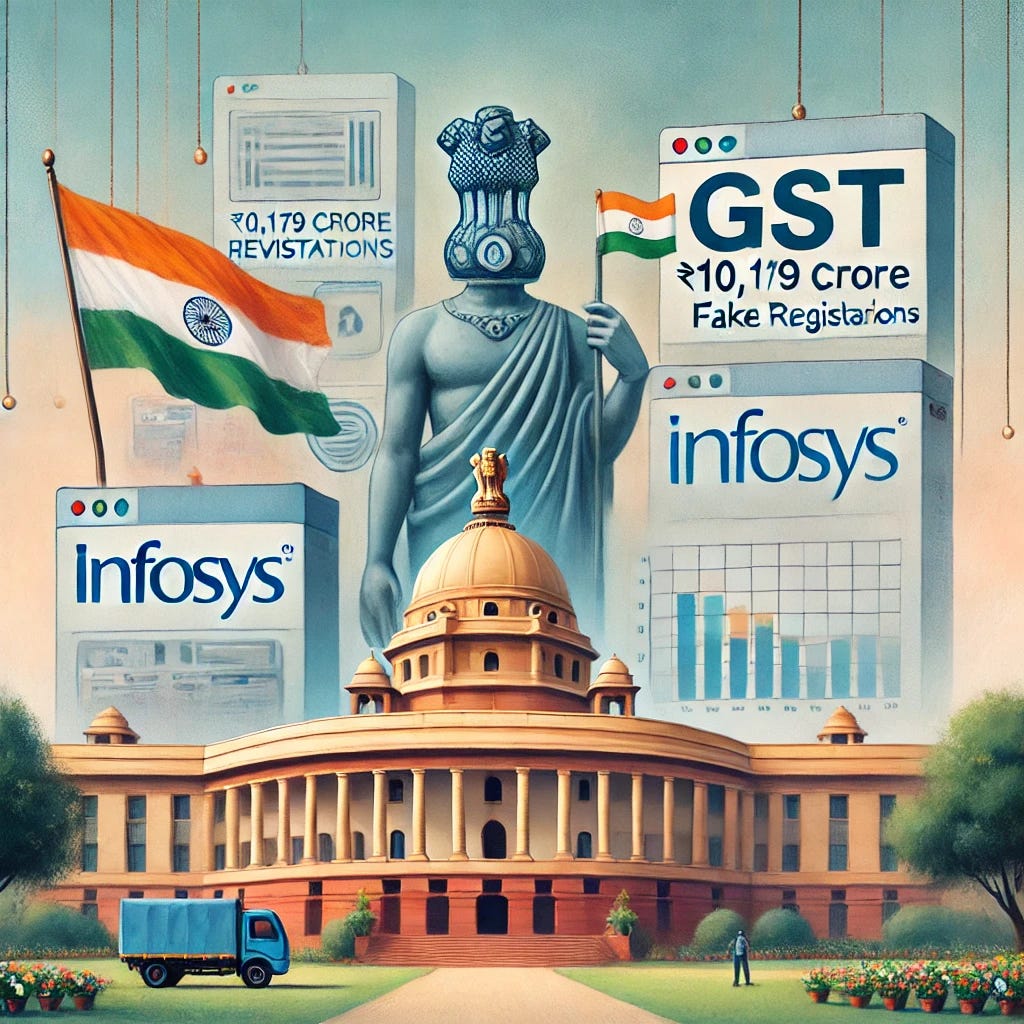GST Fraud Detected: ₹10,179 Crore Evasion Through Fake Registrations
Comprehensive reforms, improved inter-agency coordination, and better technological safeguards are essential to plug the loopholes.
Massive GST Fraud: ₹10,179 Crore Evasion Detected
Introduction
In a major operation, indirect tax authorities have recently detected over 10,700 fake GST registrations across India, exposing a colossal ₹10,179 crore (approximately $1.22 billion) in tax evasion. While this discovery is being touted as a significant achievement by the government officers, it underscores glaring systemic issues within the Goods and Services Tax (GST) framework. Seven years after the GST's much-publicised launch as a "One Country, One Tax" initiative, these frauds reflect deeper flaws that require immediate attention1.
The Uncovered Fraud: Scale and Scope
The recent crackdown, part of a national initiative, has brought to light 10,700 fake GST registrations used to defraud the tax system. Investigators identified 67,970 suspicious GST Identification Numbers (GSTINs), of which nearly 60% have been verified. Shockingly, over 27% of these GSTINs were non-existent businesses, leading to an estimated ₹10,179 crore in tax evasion.
As part of this drive, authorities blocked ₹2,994 crore in Input Tax Credit (ITC) linked to these fake registrations, but actual recoveries have amounted to only ₹28 crore—a mere fraction of the overall evaded amount. These figures cast a shadow on the success of the operation, as they reveal the inherent difficulties in recovering taxes once fraud has been committed.
A Pattern of Fraud: Previous Evasions
This isn’t the first time such a large-scale fraud has been detected under the GST regime. In 2023, a similar national crackdown uncovered 21,791 non-existent entities holding fraudulent GST registrations, which led to the detection of ₹24,010 crore in suspected tax evasion. That operation, much like the current one, highlighted the ease with which fake registrations could be obtained due to weaknesses in the registration and monitoring processes.
Between 2020 and 2023, the Directorate General of GST Intelligence (DGGI) detected over 6,000 fake Input Tax Credit (ITC) cases, amounting to ₹57,000 crore in GST fraud. In the fiscal year 2023-24 alone, GST evasion to the tune of ₹1.36 lakh crore was detected. Despite these significant frauds being uncovered year after year, the system seems unable to plug the recurring loopholes effectively.
Bolting the Stable After the Horses Have Fled?
The government’s response to the recent revelations has been characterised as an important step toward cleaning up the GST system. However, critics argue that these efforts resemble "bolting the stable after the horses have fled." The fact that it has taken seven years to detect such large-scale fraud points to severe lapses in both the design and implementation of the GST system.
At the heart of the issue is the system software developed by Infosys, a major technology player. The repeated detection of such fraudulent activities indicates serious deficiencies in the architecture of the GST framework. Either the software was rolled out in indecent haste, or there was a lack of thorough testing before it was deployed2. This situation has been exacerbated by small businesses, which have long struggled with cumbersome compliance requirements, incurring significant costs in terms of time, energy, and resources.
Systemic Issues: Weaknesses in Verification and Coordination
The magnitude of the fraud points to fundamental weaknesses in the GST registration and verification processes. The reliance on Aadhaar authentication and physical verification of businesses—measures that are only now being implemented across various states—seems insufficient to prevent such large-scale fraud. By October 2024, the government plans to expand Aadhaar-based verification to 20 states, but this reactive measure might prove to be too little, too late.
Another significant issue is the lack of coordination between state police and GST officials at both the central and state levels. The sheer scale and sophistication of the fraud indicate that communication breakdowns between these agencies have contributed to the delay in detecting and addressing these fake registrations. Without seamless coordination, fraudulent entities can exploit gaps in the system, making recovery a daunting task once the fraud is discovered.
Temporary Fixes or Long-term Solutions?
While the government's measures—including the introduction of the Invoice Management System (IMS) in October 2024—are steps in the right direction, they fall short of addressing the fundamental issues plaguing the GST framework. These piecemeal fixes may grab media headlines, but they do little to address the structural flaws within the system. The ₹10,179 crore fraud uncovered is just one incident in a series of recurring frauds that point to deeper problems.
Unless the GST framework undergoes a comprehensive reassessment, the problem will only worsen as the Indian economy grows. As businesses expand and transactions become more complex, fraud will likely evolve to exploit new loopholes. The authorities must shift their focus from reactive crackdowns to implementing preventative measures that secure the system at its core.
The Path Forward: Reinventing GST Compliance
As India aims to grow into a $5 trillion economy, the GST regime must evolve to support this ambition. The recurring frauds expose the urgent need for a transparent, user-friendly, and robust taxation system. The government's reliance on temporary solutions like special drives and software upgrades will not suffice. Comprehensive reforms, improved inter-agency coordination, and better technological safeguards are essential to plug the gaps.
Without these changes, the cycle of tax fraud and evasion will persist, continuing to undermine the core principles of the "One Country, One Tax" initiative. The government must act swiftly and decisively before this problem spirals beyond control. We owe it to lower- and middle-income families, who bear a disproportionate burden of GST in relation to their disposable incomes, as well as to the honest taxpayer. Every rupee collected should be efficiently utilised by both the Union and the States for holistic development, ultimately leading to a "Viksit Bharat."
Citations:
[1] Indian Express - GST Fraud Uncovered
[2] CA Club India - GST Fraud Case
[3] Economic Times - Infosys GST System
[4] Business Standard - All India Fake GST Registration Drive
[5] India TV News - Fake GST Firms Uncovered
Rs 44,000 Crore GST Fraud: How did Infosys's Software Allow this Systemic Daylight Robbery?
Systemic Failure Acknowledged by GST Department








